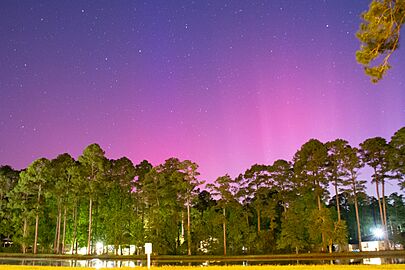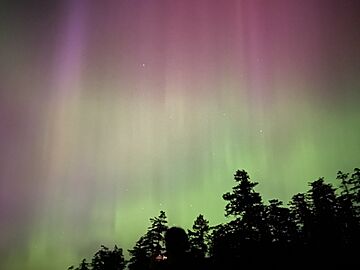May 2024 solar storms facts for kids

|
|
| Date | May 2024 |
|---|---|
| Type | Coronal mass ejection |
| Part of Solar cycle 25 | |
The solar storms of May 2024 are an ongoing powerful series of solar storms with intense to extreme solar flare and geomagnetic storm components ongoing since 10 May 2024, during solar cycle 25. The storm produced aurorae at far lower latitudes than usual in both northern and southern hemispheres.
Contents
Solar flares and coronal mass ejections
On 8 May 2024, a solar active region, which had been assigned the NOAA region number 3664, produced multiple near X-class and X-class solar flares and launched several coronal mass ejections (CME) in Earth's direction. The following day, the active region produced two additional X-class flares (X2.25 and X1.12) associated with two full-halo CMEs. The region produced X3.98 flare the next day and on 11 May it produced X5.89 flare with another asymmetrical full-halo CME. The region also caused a S1 solar radiation storm with spikes to S2.
The eruption of an additional X5.4-class solar flare was reported 11 May 2024 at 01:23 UTC.
Geomagnetic storm
Three CMEs from 8 May reached Earth on 10 May 17Z, causing severe to extreme geomagnetic storm with bright and very long-lasting aurorae. Aurorae could be seen from Europe immediately after sunset even in Croatia. In America the aurora was seen even from Florida. In southern hemisphere the aurora was seen in New Zealand, Australia, Chile and Argentina. Interplanetary magnetic field reached 73 nT and Bz was oriented strongly south, reaching -50 nT, along with somewhat high density and elevated solar wind speed reaching 750-800 km/s, this was the reason to rate the storm G5, making it most intense storm since the 2003 Halloween solar storms. Several other CMEs are expected to reach on May 11 and 12.
Comparison to other solar storms
The disturbance storm time index is a measure in the context of space weather. A negative Dst value means that Earth's magnetic field is weakened. This is particularly the case during solar storms. The May 1921 geomagnetic storm had estimates of intensity of Dst = −907±132 nT, whilst estimates for the Carrington Event superstorm of 1859 are between −800 nT and −1750 nT.
Currently, the highest negative measurement for the May 2024 solar storms is −412 nT.
Gallery
Aurorae
-
Aurora as seen from Osage Beach, Missouri
-
Aurora as seen from Pawleys Island, South Carolina
-
Aurora as seen from East Sussex, UK
-
Aurora as seen from Okeford Hill, Dorset, UK
-
Aurora as seen from Bay View, Washington
-
Aurora as seen from Kraków, Poland
See also
 In Spanish: Tormentas solares de mayo de 2024 para niños
In Spanish: Tormentas solares de mayo de 2024 para niños
- List of solar storms








